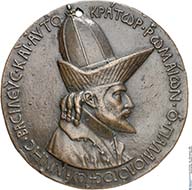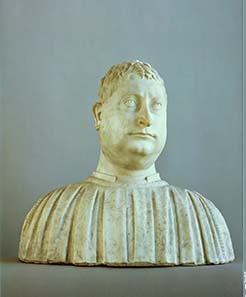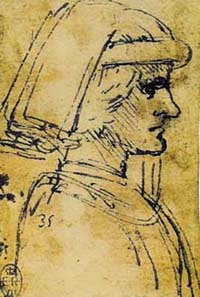August 25, 2011 – The Gemäldegalerie Berlin and the Metropolitan Museum of Art in New York have undertaken a landmark project tracing the development of the Italian portrait in the fifteenth century.
Pisanello, medal in honor of John VIII Palaiologos, 1438/9. © Münzkabinett, Staatliche Museen zu Berlin.
In Berlin the event takes place in autumn 2011 in the beautifully restored Bode-Museum, it is subsequently on view at the Metropolitan Museum. The show is placed under the auspices of the Foreign Office of the Federal Republic of Germany.
Mino da Fiesole, bust of Niccolò Strozzi, 1454. Marble. © Skulpturensammlung, Staatliche Museen zu Berlin.
In portraiture sometimes the principal motive is simply to preserve a likeness – a record or memory of the salient traits of an individual. At other times social rank, marital status or dynastic or generational relationships are suggested by adherence to a convention, type of dress, or the inclusion of various emblems or attributes.
Leon Battista Alberti. Self portrait, ca. 1432/35. Washington, The National Gallery of Art. © Art Ressource, New York.
Italian portraiture evolves in the shadow of classical models, but it is no less aware of the innovations and powerful naturalism of the great painters of the Netherlands. It is informed by humanist discussions about the individual, but also by an acute sense of social hierarchy and by a poetics of beauty that frequently transformed female sitters into and idealized likeness.
Gian Christoforo Romano, medal in honor of Isabella d’Este, ca 1498. Vienna Kunsthistorisches Museum. © Kunsthistorisches Museum, Vienna.
Exploring the rise and the development of the individual portrait thus means dealing with a complex story, the character of which changes depending on where one is and when. The show will focus on the complex history of the portrait in Florence from Donatello and Masaccio down to Verrocchio and Botticelli; it will study portraiture at the courts of northern Italy, from Pisanello to Mantegna and Francesco Laurana as well as the development of portraiture in Venice from Giambono to Antonello da Messina, Bellini and the Lombardi.
Leonardo da Vinci, portrait of Lorenzo de’ Medici, ca 1480. Collection of her majesty Elisabeth II, queen of England, Windsor Castle. © bpk / Scala.
Scholarship has vastly increased our sensitivity to the social and cultural factors that informed and shaped the formal types and typological norms of Renaissance portraiture. But precisely because these factors varied from region to region and in point of time, the exhibition avoids imposing typological categories on what seems to be a fascinatingly rich exchange of ideas. Instead, it seeks to elucidate the strands of these narratives in Florence, Venice and the courts of northern Italy through a series of telling juxtapositions involving paintings, sculpture, medals and drawings. In other words, it aims to provide a place and occasion for the defining works of fifteenth-century portraiture to speak to each other, all the while acknowledging regional and cultural accents.
There is a website dedicated to the exhibition. Click here.
And you will see a lot of films at YouTube.
And there even is an app for your iPhone. For a download click here.









